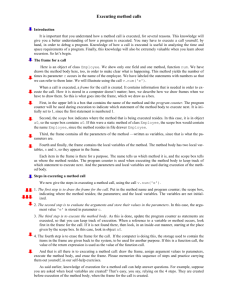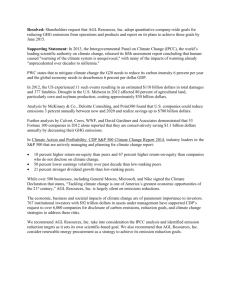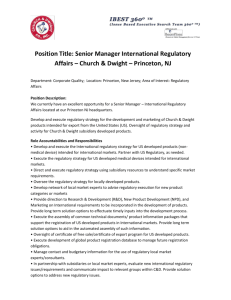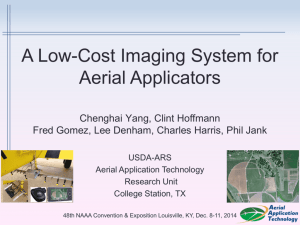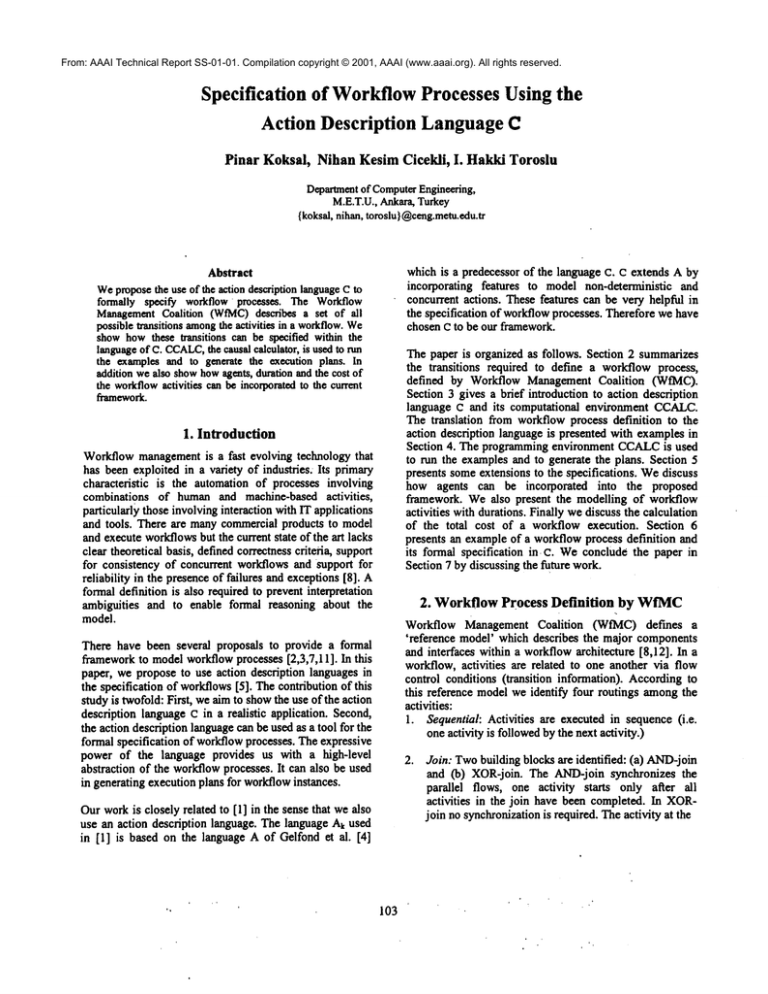
From: AAAI Technical Report SS-01-01. Compilation copyright © 2001, AAAI (www.aaai.org). All rights reserved.
Specification of Workflow
Processes Using the
Action Description LanguageC
Pinar Koksal, Nihan Kesim Cicekli,
I. Hakki Toroslu
Department
of Computer
Engineering,
M.E.T.U.,Ankara,Turkey
{koksal,nihan,toroslu}@ceng.metu.edu.tr
Abstract
Weproposethe use of the action descriptionlanguageC to
formally specify workf]owl processes. The Workf]ow
Management
Coalition (WfMC)describes a set of all
possibletransitions among
the activities in a workflow.
We
showhowthese transitions can be specified within the
languageof C. CCALC,
the causalcalculator, is usedto run
the examplesand to generate the execution plans. In
additionwealso showhowagents, durationand the cost of
the workflow
activities can be incorporatedto the current
framework.
which is a predecessor of the language C. C extends A by
incorporating features to model non-deterministic and
concurrent actions. These features can be very helpful in
the specification of workflowprocesses. Therefore we have
chosenC to be our framework.
The paper is organized as follows. Section 2 summarizes
the transitions required to define a worldiowprocess,
defined by Worldlow ManagementCoalition (WflVIC).
Section 3 gives a brief introduction to action description
language C and its computational environment CCALC.
The translation from workflowprocess definition to the
action description languageis presented with examplesin
Section 4. The programmingenvironment CCALC
is used
to run the examplesand to generate the plans. Section 5
presents someextensions to the specifications. Wediscuss
how agents can be incorporated into the proposed
framework. Wealso present the modelling of workflow
activities with durations. Finally we discuss the calculation
of the total cost of a workflow execution. Section 6
presents an exampleof a workflowprocess definition and
its formal specification in C. Weconclude the paper in
Section 7 by discussing the future work.
1. Introduction
Workflowmanagementis a fast evolving technology that
has been exploited in a variety of industries. Its primary
characteristic is the automation of processes involving
combinations of humanand machine-based activities,
particularly those involvinginteraction with IT applications
and tools. There are manycommercialproducts to model
and execute workflowsbut the current state of the art lacks
clear theoretical basis, definedcorrectnesscriteria, support
for consistency of concurrent workflowsand support for
reliability in the presenceof failures and exceptions[8]. A
formaldefinition is also required to preventinterpretation
ambiguities and to enable formal reasoning about the
model.
2. Workfiow Process
Definition
by WfMC
Worka-elow Management Coalition (WfMC)defmes
’reference model’ which describes the major components
and interfaces within a workflowarchitecture [8,12]. In a
worldlow,activities are related to one another via flow
control conditions (transition information). According
this reference modelwe identify four routings amongthe
activities:
1. Sequential: Activities are executed in sequence(i.e.
one activity is followedby the next activity.)
There have been several proposals to provide a formal
frameworkto modelworkflowprocesses [2,3,7,11]. In this
paper, we propose to use action description languages in
the specification of workflows[5]. The contribution of this
study is twofold:First, we aimto showthe use of the action
description languagec in a realistic application. Second,
the action description languagecan be used as a tool for the
formal specification of workflowprocesses. The expressive
power of the language provides us with a high-level
abstraction of the workflowprocesses. It can also be used
in generating executionplans for workflowinstances.
.
Ourworkis closely related to [1] in the sense that we also
use an action description language. The language Akused
in [1] is based on the language A of Gelfond et al. [4]
103
Join: Twobuilding blocks are identified: (a) AND-join
and (b) XOR-join. The AND-join synchronizes the
parallel flows, one activity starts only after all
activities in the join have been completed. In XORjoin no synchronizationis required. Theactivity at the
.’ .. ,
joincanstart
whenanyoneoftheincoming
activities
has
beencompleted.
.
4."
Split: The AND-splitenables two or moreactivities to
be executed concurrently after another activity has
been completed.If the transitions have conditions the
actual numberof executed parallel activities depends
on the conditions associated with each transition which
are evaluated concurrently. In XOR-SPLIT
the decision
as to whichsingle transition route is selected depends
on the conditions of each individual transition as they
are evaluatedin the sequencespecified in the list.
Loop:It maysometimesbe necessary to execute an
activity or a set of activities multipletimes.
In the rest of the paper, wediscuss howthese features of a
workflow management system can be modeled in the
framework of the language C. Wefirst give a brief
summary
of the action description languageC.
3. Action Description
Language C
z
The action description language~, is first defined in [6],
based on the theory of causal explanation proposed by
McCainand Turner [10]. Non-deterministic actions and
concurrent execution of actions can be conveniently
described in C. Inertia is not a ’built-in feature’ in the
semantics of c; the user is free to decide for each fluent
whetheror not to postulate inertia for it. Thepropositions
of the action languageC are classified into static laws and
dynamiclaws. Static laws are of the form
caused
F if O
and dynamiclaws are of the form
caused F ~.£ G after H
where, F and (3 stand for propositional combinations of
fluent names and H is propositional combination of the
fluent namesand action names.The syntax of the language
C includes someshort and convenient notation in order to
specify somefrequently used expressions. Here we give a
summaryof only somethese expressions. An expression of
the form
U causes F if G
where U is a propositional combination of elementary
action namesand F, G are state formulas, stands for the
dynamic law
caused F if True. after G A U.
Anexpression of the form
nonexecutable U if F
where U is a propositional combination of elementary
action names and F is a state formula, stands for the
dynamic law
caused False after F A U.
The Causal Calculator [9], CCALC,
is a modelchecker for
the language of causal theories. Using rewrite rules,
propositions in C can be translated into the language of
104
causal theories. Therefore c is used as an input language
for query answeringand planning with the Causal
Calculator. Finding a satisfying interpretation showsthat
there exists a causally possible worldhistory in whichthe
plan is executed(in the initial state of the interpretation)
and the goal is achieved. It does not, however,guarantee
the plan is valid, i.e., that the plan will necessarily achieve
the goal if the plan is executed in the initial state of the
interpretation, or that it can be so executed.
4. Workflow Process
Specification
with C
Anyworkflowprocess can be defined using the transitions
defined by WfMC,
given in Section 2. In this section, we
give the translations oftbese transitions into propositionsin
¢. In order to define a workflow process using C
propositions, we should first decide about the constanta,
actions and fluen~ of the system. Each activity in the
worldlowprocess is represented by a constant name(say,
A~). The action whichdenotes the execution of an activity
is represented
by:execute
(actiwi
ty).In addition
we
definethe following(inertial) flu~.ts:
¯
commit(activity) : It ’is }’alse initially.
It
becomestrue after the workflowactivity commits(i.e.
aftertheaction
execute
(act ivity)is done).
¯ cond(activity)
: This fluent is used to define the
necessary conditions in AND-SPLIT,XOR-SPLIT,
and LOOP
transitions.
¯
count (number) : It is used as a loop counter in the
specificationof looptransitions.
4.1 Sequential Transition
In this transition, actions are executedin sequential order.
After a workflowactivity commits,the next activity in the
specification can start execution. Theactivity diagramof a
sequentialtransition is givenin Figure1.
Figure 1. Activity Diagram
In Ccalc, states are described by the values of the fluents.
The execution of an action causes a change from one state
to another. The following state diagramin Figure 2, shows
the states of the example sequential transition whose
activity diagram is given above. This transition can be
definedin C as:
execute(Aa)causes commit (Aa) ¯
execute(A2) causes commit (A2)
i f commit(Aa).
nonexecutableexecute (actl
if commit(actl)
/" ,., ~ ..... . .... =commit(A1)
~,ooJ
[ -commit(A2)
4.3 XOR-SPLITTransition
XOR-split transitions are similar to the AND-SPLIT
transitions graphically, but only one of the alternative
activities is executed.In order to represent suchtransitions,
the following rules are added to the AND_SPLIT
transition
definition:
..........
i
nonexecutable execute (A1)
execute(A2) && .. && execute(An).
nonexecutableexecute (act1)
if commit (act2) && - (act2=A).
.---.----~- ¢ommit(A
1)
.~"~ ~ commit(A2)
where act1and act2are variables of activity
sort.
With the first rule, we state that, although there maybe
more than one activity for which the associated condition
is true, one and only one of themcan execute in the same
state. Withthe secondrule we say that, if any one of the
activities A1... A n is committedin one state, the other
activities cannotbe executedin the next states.
Figure 2. State Diagram
where actl is a variable of activity sort and A1 and
Aa are the activities givenin the example.Withthese rules,
werepresent that, the activity A, can be executedonly if the
activity A, commits.In addition, we ensure that once the
activity A, or A2eornmit,they are not executedagain.
4.4 AND-JOIN Transitions
The execution of the activity at the join dependson the
synchronization of the preeeeding concurrently running
activities A1...A, (Figure 4). Theactivity Acan be executed
only after all of themhave committed.
4.2 AND-SPLITtransition
In the AND-SPLIT
transition after an activity commits,one
or moreactivities can start executing concurrently. Their
execution dependson the truth value of their associated
conditions. Here, we needto use the concurrent actions in
modelingthe executionof concurrentactivities.
Figure 4. AND-JOIN
transition
This transition can be described in C as follows:
execute(A)
causes commit (A)
if commit(At) && .. && commit(A.).
4.5 XOR-JOINTransitions
The difference between an AND-JOINand XOR-JOINis
that the activity at the join does not needto wait for the
commit of all incoming activities. Instead, it can be
executed if any one of themcommits:
Figure 3: AND-SPLIT
transition
As shownin Figure 3, when the activity A commits, the
activities (Aa, As .... A,) for which the associated
conditionholds, are executedconcurrentlyin the next state.
Thistransition is representedby n rules of the form:
execute(A) causes commit (A)
if commit(Aa) .
execute(Aj ) causescon~i(Aj )
if commit(A) && cond(Aj).
One such rule is written for every activity Ajsuch that
i _< j _< n. This set of rules represents that if any one
of the activities AI ... A, has committed,the activity A can
execute.
Onesuch rule is written for every activity Aa such that i _<
j _< n. The other rule of the sequential transition
definition (nonexecutable)remains the same.
nonexecutab1e execute (ac tl
if commit (act2) && - (actl=A).
105
where actland act2are variables of activity sort.
Withthis rule westate that, if any one of the activities AI
throughA, is committedin one state; in the next states, the
other activities, other than the activity A, cannot start
execution.
4.6 LOOPTransitions
In a LOOPtransition, we can include any one of the
transitions described so far. Here wegive an exampleof a
LOOP
that includes sequential transitions only.
In the LOOP
transition, the executionof the activities in the
loopis repeateduntil the loop conditionis false. Thevalue
of the condition can be changed by the execution of
activities in the loop, or by changingthe value of a counter.
In Figure 5, an iteration of a set of sequentially ordered
activities is illustrated. Assume
that the loopis executedfor
a given numberof times.
5.1 Agents
Whenthere are agents, each qualified to execute someor
all of the workflowactivities, additional rules must be
included to describe their behaviour. The following
requirements should be supported:
¯ Activities can. be executed only by those agents that
are qualified to do so.
¯ The agents can run activities if they are not occupied
by another activity. In other words, one agent can
executeonlyone activity at a time.
¯
In an AND-SPLIT
transition, althoughit is desired, the
activities in the split maynot be executedconcurrently
if all the qualified agents are occupied. This may
happen whenthe numberof qualified agents is less
than the number
of activities in the split.
To support these requirements,
execute(activity)
is modified as:
the action
execute(agent, activity) : : action
to explicitly specify which agent executes the activity.
Also, the fluent:
qualified(agent,activity):
inertialFluent
Figure 5. A LOOP
transition
The modelingof A1through An is similar to the sequential
transition. However,
since this sequential transition appears
in a LOOP
transition, the activities A~to A,, should be
executed several times. In order to achieve this, the
execution of the last activity of the LOOP
transition, A,,
causes the commit fluents to be false again. Wedescribe
this behaviourby the followingrule:
execute(An) causes-commit (actl) &&count
if count(I) && sum(J,I,l) && -(A=actl).
where sum(i, j, k) is a macro definition
calculates i = j + k.
that
is added to describe whether the agent is qualified to
executethe activity or not.
As an example, a sequential transition including three
activities and three agents can be defined in CCALC
as the
following:
execute(agl, AI) causes commit(Al)
if qualified(agl, AI).
execute(agl, A2) causes commit (A2)
if qualified(agl, A2)
commit(AI)
execute(agl , A3 ) causescommit(A3
if qualified(agl, A3)
commit(A2)
Therule:
caused -count (I) if count (J) && - (I=J).
is to state that only one of the count(number)
fiuents
can be true any time.
One activity (actl)
cannot be executed by more than one
agent at the sametime:
nonexecutable execute(agl, actl)
execute(ag2, actl) if-(agl = ag2).
5. Extensions to the Specifications
In this section wediscuss several possible extensionsto the
specification of a worldlowwithin the current framework.
Theseextensionsinclude agent assignmentto the activities,
modelingactivities with duration and calculation of the
executioncost of a workflow.
106
Oneagent (agl) cannot execute more than one activity at
the sametime:
nonexecutable execute(agl, actl)
execute(agl, act2) if -(actl = act2).
Oneactivity cannot be executed again once it commits:
nonexecutable execute (agl, act1)
commit(act1)
6. An Example Workflow Definition
In additiontp these rules, the facts to specify whichagents
are qualified to execute which activities needs to be
includedto the specification.
In this section, we give an exampleworkflowand describe
howit is translated to the action description languageC.
Figure 6 showsthe exampleworkflowprocess which is to
be executedby twoagents X and Y. The first activity in the
workflow is A1. Whenthis activity commits, the next
activity A2 executes. After A2commits,activities A3and
A4 run concurrently. Whenboth A3 and A4 commit,
activities A5 and A6execute in a sequential manner.Then
the worktlow process terminates. The figure shows the
activity diagramand the qualified agents for each activity.
5.2 Activities with Duration
We have so far modeled workflow activities
as
instantaneousactions. However,
in real worldthe activities
have durations for their execution. Thus we need to
formalize different states of activities. In other wordswe
need to be able to model an activity to be executing,
committed,not started, etc. In order to modelactivities
withduration, weintroducethe action start(agent, activity)
in addition to the action execute(agent, activity), four
fluents: executing(agent, activity, number1), committed
(activity), duration(agent, activity,
numberl) and
free(agenO.Weadd the following rules:
Agentx
~
start (agl, AI) causes
executing(agl, AI, O) &&-free(agl)if
qualified(agl, A1) && free(agl).
execute (agl, A1) causes
executing(agl, A1, I)
executing(agl, A1, J) && suml(I,
&& duration(agl, A1, K)&&(K >
execute(agl, A1) causes
committed(agl, A1) && free(agl)
executing(agl, A1, J) && suml(I,
&& duration(agl, A1, K)&&(K=I).
gents
X,Y
Agents X, ~~
/~Agent
Y
i)
I)
An action execute(agent,
act)causesan increment
on the executiontime of the activity (third argumentof the
fluent executing(agl, act, I) denotes the current
executiontime).
Figure 6. An exampleworkflowprocess
The CCALC
definition of this workflowprocess is given as
follows:
start (agent1, A1) causes
executing(agent1, A1, 1)
-free(agent1)
qualified(agentl,A1)
free(agent1)
5.3 Cost of a WorkflowExecution
Each worldlowactivity has an execution cost (e.g. time)
that sumsup to the total cost of the workflowexecution. In
order to calculate the total cost of executing a worldlow
instance, we add the fluents, totalcost(nUmber),cost(agent,
activity, number)to our frameworkand we modifythe rules
aboveas follows:
start (agent1, A2) causes
executing(agent1, A2, 1) &&
-free(agent1)
qualified(agent1, A2)
free (agent1)
committed(AI)
execute(agl , act1) causes
committed(act1) && totalcost(I)
if qualified(agl, act1) &&totalcost(K)
&& cost(agl, act1, J) && sum(I, K,
start (agent1, A3) causes
executing(agent1, A3, 1)
-free(agentl)
qualified(agent1, A3)
free (agent1) && committed(A2).
Weare planningto use this calculation to find the plan with
minimumcost.
107
start(agentl, A4) causes
executing(agentl, A4, i)
-free(agentl)
qualified(agentl, A4)
free(agentl)
commit ted (A2)
caused -totalcost(I2)
&& -(I2=J2).
&&
7.
start(agentl, A6) causes
executing(agentl, A6, i)
-free(agentl)
qualified(agentl, A6)
free(agentl)
committed (A5 )
execute(agentl, activityl) causes
committed (acti vi tyl )
free (agentl) && totalcost (L)
if executing(agentl, activityl, J)
sum(I, J, i)
duration(agentl, activityl, K)
(K = I) && totalcost (M)
cost(agentl, activityl, N)
sum(L, M, N).
and Future
Work
In this paper we have presented our preliminary results on
the use of the action description
language c in the
specification of workflow processes. Wehave implemented
all the rules presented in this paper using CCALCand
observed that the action description language C can be used
as a specification tool to model simple workflow processes.
It is also observed that CCALC
generates correct plans for
the execution of a workflow instance. However, CCALC
uses satisfiability solvers, sato [13] or tel-sat, whichdo not
generate alternative plans. On the other hand we need to be
able to generate alternative worldlow executions in order to
do verification
of a work_flow specification.
Therefore
’smodela’ must be studied further to see whether any
modifications can be made to satisfy our needs.
start (agentl, A5) causes
executing(agentl, A5, i)
-free (agentl)
qualified(agent1, AS)
free(agentl)
committed(A3) && committed(A4).
execute(agentl, activityl) causes
executing(agentl, activi tyl, I)
if executing(agentl, activityl, J)
sum (I, J, i)
duration(agentl, activityl, K)
(K>I)
Conclusion
if totalcost(J2)
Weplan to continue on this topic in several directions
including the problem areas like constraint programming,
optimum schedule development, verification
of the
specifications,
developing
a high level workflow
specification
language on top of c and a visual
programming environment.
Among these research
directions
we have already started
to work on the
development of the high-level
workflow specification
language and visualization of transition systems.
&&
&&
References
[1] Baral, C., Lobo, J., ’Formalizing Workflows as
Cooperative Agents’, Dynamics ’97, Workshop in ILPS,
1997.
nonexecu table start (agentl , activi tyl
if executing(agent2, activityl).
[2] Cicekli-Kesim, N. A Temporal Reasoning Approach to
Model Workflow Activities,
Lecture Notes in Computer
Science, no. 1649, ed. R.Y. Pinter and S. Tsur, NGITS’99,
Zikhron-Yaakov, Israel, July 1999.
nonexecutable start (agentl , activi tyl
i f commit ted (ac ti vi tyl ).
nonexecu table execute (agentl , acti vi tyl
if commi tied (activi tyl).
[3] Davulcu, H., M. Kifer, C.R. Ramakrishnan, and I.V.
Ramakrishnan. Logic Based Modeling and Analysis of
Workflows. In ACMSymposium on Principles of Database
Systems; Seattle, Washington, ACMPress, 1998.
nonexecutable start (agentl , acti vi tyl
&& start(agent2, activityl)
- (agentl=agent2).
[4] Gelfond, M., Lifschitz, V., ’Representing Action and
Change by Logic Programs’,
Journal
of Logic
Programming, Vol.17, pp. 301-321, 1993.
caused -execu ring (agentl, acti vi tyl , I)
i f execu ring (agentl, actl, J)
- (I=J).
[5] Gelfond, M., Lifschitz,
V., ’Action Languages’, in
Electronic Transitions on AI, Vol.3. No:16, 1998.
caused -execu ring (agen tl , activi tyl , I)
if committed(actl).
108
[6] Giunchiglia, E., Lifschitz, V., ’An Action Language
Based on Causal Explanation: Preliminary Report’, Proc.
of AAAI-98,pp. 623-630, 1998.
[7] Harel, D. StateCharts: A Visual Formalism for
Complex Systems. Science of Computer Programming,
8:231-274,1987.
[8] Hollingsworth, D., ’WorkflowManagement
Coalition The Workflow Reference Model’, Document No: TC001003, January 1995.
[9] McCain,N., ’Using the Causal Calculator with the C
Input Language’,1999.
[10] McCain,N., Turner, H., ’Causal The.odes of Action
and Change’,Proc. of AAAI-97,pp. 460..465, 1997.
[I I] Singl~M., Meredith,G., Tomlinson,C., Attic, P., "An
Event Algebra for Specifying and Scheduling Workflows’,
4th Intl. Conf. On Database Systems for Advances
Applications (DASFAA),
Singapore, April 1995.
[12] WilVIC,’WorkflowManagement
Coalition - Interface
1 : Process Definition Interchange Process Model’,
DocumentNo: TC- 1016-P, November
1998.
[13] Zhang, H., ’SATO: An Efficient Propositional
Prover’, Proc. of the Intl. Conf. on AutomatedDeduction
(CADE-97),1997.
109
.
::.,


